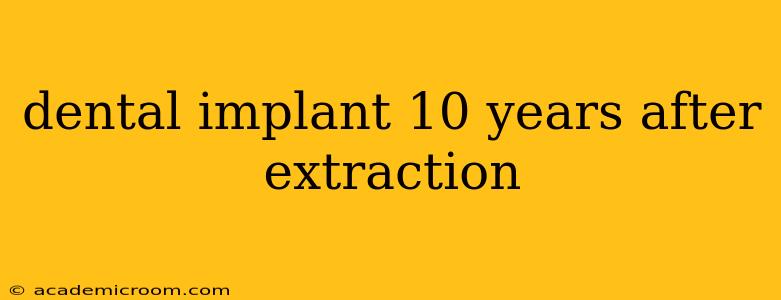Getting a dental implant ten years after an extraction is a common scenario, and while possible, it requires a careful assessment by a qualified periodontist or oral surgeon. This comprehensive guide will explore the feasibility, the process, and factors to consider when pursuing dental implants this far after tooth loss.
Is it Possible to Get a Dental Implant 10 Years After Extraction?
Yes, it's absolutely possible to get a dental implant 10 years after tooth extraction. However, the success of the procedure depends heavily on the condition of your jawbone and overall oral health. Bone loss is a natural process following tooth extraction, and after a decade, significant bone resorption might have occurred. This bone loss can compromise the stability and longevity of the implant.
What Happens to Your Jawbone After Tooth Extraction?
After a tooth is extracted, the jawbone gradually loses density and volume due to a lack of stimulation from the tooth root. This process, known as bone resorption, can significantly impact the placement of dental implants. The less bone available, the more challenging—and potentially more costly—the implant procedure becomes.
How Does Bone Loss Affect Dental Implant Placement?
Insufficient bone height or width can prevent the successful placement of an implant. A lack of adequate bone can lead to:
- Implant Failure: The implant might not integrate properly with the jawbone, leading to loosening or rejection.
- Increased Surgical Complexity: Bone grafting procedures might be necessary to augment the bone before implant placement. This adds time and cost to the overall procedure.
- Compromised Aesthetics: Insufficient bone can affect the final restoration's appearance, potentially leading to an unnatural-looking result.
What are the Procedures Involved in Getting a Dental Implant 10 Years After Extraction?
The process usually involves several stages:
- Initial Consultation and Examination: A thorough examination will assess your jawbone density using X-rays or CBCT scans. Your overall oral health will also be evaluated.
- Bone Grafting (if necessary): If bone loss is significant, a bone graft will be performed to augment the jawbone. This can involve using your own bone, synthetic bone grafts, or a combination of both. The bone graft needs time to heal before implant placement.
- Implant Placement: Once the bone has healed sufficiently, the dental implant is surgically placed into the jawbone.
- Osseointegration: This is the crucial healing period where the implant fuses with the jawbone. This process typically takes several months.
- Abutment Placement: Once osseointegration is complete, an abutment (a connecting piece) is attached to the implant.
- Restoration: Finally, a crown (or other restoration) is placed on the abutment, completing the dental implant process.
What are the Costs Associated with Dental Implants After 10 Years?
The cost of dental implants ten years after extraction can vary widely depending on several factors:
- Geographic Location: Costs differ significantly between regions and countries.
- Bone Grafting Needs: Extensive bone grafting procedures add substantially to the overall cost.
- Type of Implant: Different implant brands and materials have varying price points.
- Number of Implants: The cost increases proportionally with the number of implants needed.
A comprehensive consultation with your dentist or oral surgeon will provide a detailed breakdown of the expected costs.
Are There Alternative Treatments to Dental Implants?
Yes, several alternatives exist, including dentures and dental bridges. However, dental implants are generally considered the most stable and long-lasting solution for replacing missing teeth. Your dentist will discuss the best option for your specific needs and circumstances.
How Can I Maintain My Dental Implants Long-Term?
Maintaining good oral hygiene is crucial for the longevity of your dental implants. This includes:
- Brushing and flossing regularly: Use a soft-bristled toothbrush and gentle flossing techniques to avoid damaging the implant or surrounding tissues.
- Regular dental checkups: Attend regular dental checkups and professional cleanings to prevent complications and detect any issues early.
- Avoiding harmful habits: Refrain from smoking and excessive alcohol consumption, which can negatively impact implant integration and long-term success.
What are the Potential Risks and Complications?
While dental implants are generally safe and successful, potential risks and complications include:
- Infection: Infections can occur at the implant site.
- Peri-implantitis: This is an inflammation of the tissues surrounding the implant, potentially leading to implant failure.
- Nerve damage: Rarely, nerve damage can occur during the surgical procedure.
- Sinus complications (in upper jaw implants): Implants placed in the upper jaw can sometimes cause problems with the sinuses.
A thorough consultation with a qualified professional is crucial to assess your specific situation and determine the best course of action. The decision to pursue dental implants ten years after extraction requires careful consideration of individual factors, potential complications, and financial implications. Remember, open communication with your dentist is paramount throughout the entire process.
